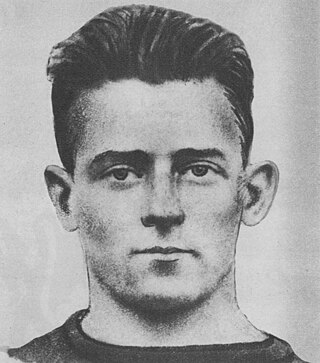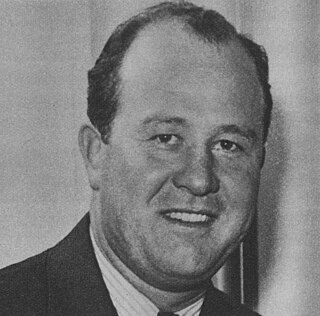Related Research Articles

James Patrick Tressel is an American college football coach and university administrator who served as president of Youngstown State University in Youngstown, Ohio from 2014 to 2023. Before becoming an administrator, Tressel was the head football coach of the Youngstown State Penguins and later the Ohio State Buckeyes in a career that spanned from 1986 until 2010. Tressel's teams earned several national championships during the course of his career, earning him numerous accolades.

W. Harold Anderson was an American college men's basketball coach at Bowling Green State University and the University of Toledo. As a player, he played at Otterbein College, a small liberal arts college outside Columbus, Ohio. As a coach he was one of the first to win more than 500 games on the collegiate level. Anderson was inducted into the Naismith Basketball Hall of Fame in 1985 and the College Basketball Hall of Fame in 2006.

Jack LeRoy Christiansen was an American professional football player who became a college and pro coach. He played professionally in the National Football League (NFL) for the Detroit Lions as a safety and return specialist from 1951 to 1958. He helped lead the Lions to three NFL championships in 1952, 1953, and 1957 and was a first-team All-NFL player in six of his eight years in the league. He led the NFL in interceptions in 1953 and 1957 and in punt returns for touchdown in 1951, 1952, 1954, and 1956. His eight career punt returns for touchdowns was an NFL record until 1989 and remains the fourth best in league history. He was inducted into the Pro Football Hall of Fame in 1970.

Ronald John Kramer was an American professional football player who was an end in the National Football League (NFL), primarily for the Green Bay Packers. A member of two NFL champion teams with the Packers, he was named to the NFL 50th Anniversary All-Time Team and Green Bay Packers Hall of Fame.

Frank Francis Sinkwich Sr. was a Croatian-Yugoslav American football player and coach. He won the Heisman Trophy in 1942 while playing for the Georgia Bulldogs, making him the first recipient from the Southeastern Conference. In the course of a brief but celebrated career in professional football, Sinkwich was selected for the National Football League Most Valuable Player Award. He coached the Erie (PA) Vets semi-professional football team in 1949. Sinkwich was inducted into the College Football Hall of Fame in 1954.

Tommy Hughitt was a Canadian-American National Football League (NFL) utility player, coach, referee and politician. He was also an All-American quarterback for the University of Michigan in 1913.

Charles Teetai Ane Jr. was an American football offensive lineman who played in the National Football League (NFL) for the Detroit Lions. He played college football at the University of Southern California.

Robert Leo Patrick "Grandpappy" Dove was an American football player and coach. He played college football at the University of Notre Dame and professionally for nine seasons in the National Football League (NFL). Following his retirement as a player, Dove embarked on a 37-year coaching career at the professional and collegiate levels. He was inducted into the College Football Hall of Fame as a player in 2001.
Byron Ledare "By" Bailey born to Rollin Edward and Cora Helen (Bruner). Bailey, was a professional American and Canadian football player, primarily as a fullback and defensive back with the Canadian Football League BC Lions. Born in Omaha, Nebraska, Bailey is a member of the Canadian Football Hall of Fame, the BC Sports Hall of Fame, the B.C. Lions Wall of Fame, and the Washington State University Athletic Hall of Fame. Bailey's #38 jersey is one of eight numbers retired by the B.C. Lions. In 2006, Bailey was voted to the Honour Roll of the CFL's top 50 players of the league's modern era by Canadian sports network TSN.

Charles Emile "Gus" Dorais was an American football player, coach, and athletic administrator.
Robert Babich was an American professional football player who was a linebacker for nine seasons in the National Football League (NFL) with the San Diego Chargers and the Cleveland Browns. He played college football at Miami University in Oxford, Ohio, and was elected to the College Football Hall of Fame in 1994.

Henry LeRoy Zimmerman Jr. was an American football player who played wingback and quarterback in the National Football League (NFL) from 1940 to 1948. Afterwards, he played professional fast-pitch softball for 26 years, during which he revolutionized pitching.
LaVern Earl "Torgy" Torgeson was an American football player and coach. He played college football for Washington State from 1948 through 1950. Torgeson played professionally in the National Football League (NFL) for seven seasons, principally as a linebacker, for the Detroit Lions from 1951 to 1954 and for the Washington Redskins from 1955 to 1957.

William Miller Edwards was an American football player and coach. He served as the head football coach at Western Reserve University, Vanderbilt University and Wittenberg University in a career lasting more than 30 years, compiling a win-loss-tie record of 168–45–8. Edwards also coached the Detroit Lions of the National Football League (NFL) from 1941 to 1942, tallying a 4–9–1 record, and served as an assistant coach for the NFL's Cleveland Browns in the late 1940s.
The Ironton Tanks were a semi-professional football team organized in 1919 in Ironton, Ohio.

Eli Camden Henderson was an American football, basketball, and baseball coach and college athletics administrator. He served as the head football coach at Muskingum College (1920–1922), Davis & Elkins College (1923–1934), and Marshall University (1935–1949), compiling a career college football record of 164–91–13. Henderson was also the head basketball coach at Muskingum (1920–1923), Davis & Elkins (1923–1935), and Marshall (1935–1955), tallying a career college basketball mark of 621–234. As a coach in basketball, he originated the fast break and the 2–3 zone defense, hallmarks of the modern game.

Cecil Belvedire "Cy" Souders was an American football player. He played professionally in the National Football League (NFL) with the Detroit Lions.

Stephen Nickolas Belichick was an American football player, coach, and scout. He played college football at Western Reserve University, now part of Case Western Reserve University, from 1938 to 1940 and then in the National Football League (NFL) with the Detroit Lions in 1941. After serving in World War II, Belichick began his coaching career. From 1946 to 1949, he was the head football coach and the head basketball coach at Hiram College. He continued on as an assistant coach in college football with stints at Vanderbilt University (1949–1952), the University of North Carolina at Chapel Hill (1953–1955), and then for 34 years at the United States Naval Academy (1956–1989).

Teddy Peter Topor was an American football player who played quarterback and linebacker. He played college football for the University of Michigan and professional football for the Detroit Lions.
Russell Weihr Finsterwald was an American football and basketball player and coach. He played both sports at Syracuse University between 1916 and 1917 before serving in the U.S. Army during World War I. He played professional football for the 1920 Detroit Heralds during the first regular season of the National Football League (NFL), then known as the American Professional Football Association (APFA). He also served as the head coach of the Ohio University football and men's basketball teams in the early 1920s.
References
- 1 2 3 "Sloko Gill". databaseFootball.com. Archived from the original on February 21, 2007. Retrieved November 10, 2007.
- 1 2 3 4 "Alumni Hall of Fame". Campbell Memorial High School. Retrieved November 10, 2007.